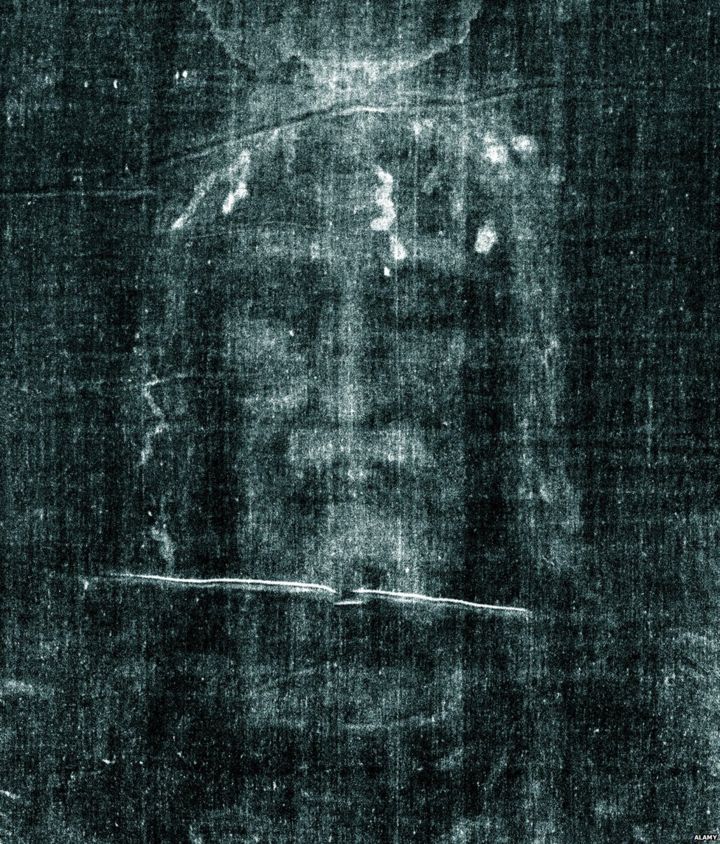The Shroud of Turin is arguably the most scientifically tested artifact in history. The debate as to whether it is a true relic or a hoax continues unabated. New tests and articles are constantly in the news. For those who believe in the authenticity of the Shroud, no further evidence is necessary. For those who believe the Shroud is a hoax, no further evidence of its authenticity will be adequate.
The Shroud is a linen cloth with faint markings which, when subjected to photographic X-ray to produce a negative image, reveals a naked man 175±2 cm tall, lying on his back with his hands crossed at the groin. He has shoulder length hair parted in the middle, a beard and a mustache. Examination of the image reveals a man who was severely beaten as well as crucified.
The debate hinges on whether the actual Shroud is a product of the first century CE or was a hoax created during the middle ages.
Among the tests that have been performed on the Shroud are: Carbon 14 dating, pollen analysis, analysis of the linen cloth and its weave, analysis of the blood stains and blood flow, analysis of the pigmentation on the Shroud to determine whether or not it was painted, and so on. Scholarly papers abound producing evidence of first century origin followed by critics of the research stating that the research was flawed.
If the Shroud is indeed a fraud, it is a magnificent hoax especially for the time in which it was said to have been created. Whoever the unknown artist was, he was not only an expert in anatomy; he had expertise in the effect of crucifixion on the body and the post mortem effects of blood flow from various wounds, not only of the crucifixion but the wounds from severe beatings on back, legs and as well as the wounds on the man’s knees showing he had fallen several times. There is also evidence of deep seated wounds and bleeding around the head. None of this is evident from an examination of the Shroud itself, but becomes very clear when photographed and viewed as a negative image. The artist was very clever indeed. The artist had to have been skilled at “painting between the lines” in order to produce an image only visible or recognizable through photographic negatives.
An interesting point about the image is that there is no evidence that the cloth was removed from a dead body more than 24 hours after interment. In other words, if this cloth had been used to wrap a bloody body after death, or even from a body in which there was an attempt to wash it prior to burial, and then was removed from the body later, there is no evidence of the cloth sticking to dried blood. Instead, the image shows no blurring at all. So the cloth could not have been pulled off or unwrapped from a dead body.
The Shroud itself is a linen cloth made from Middle East cotton and of a weave used in Syria during the first century. “The shroud contains pollen grains from 58 species of plants,” some of which are from Europe while the majority are found exclusively around the Dead Sea area. The apparent blood stains on the Shroud do contain hemoglobin. There is argument as to whether or not it was sprayed on the cloth in order to create the image.
The results of a radiocarbon dating, published in 1988, gave a date for the Shroud as being somewhere between 1260 CE and 1390 CE. Some claim that the dating is skewed as the Shroud had been in a fire which affected the dating or that the samples were taken from a piece of 14th century repair work. Those who see the Shroud as a hoax use this study as their proof. Others see it as only one of a number of 20th and 21st century scientific tests.
The Catholic Church has made no official proclamation on the authenticity of the Shroud although many Catholics accept it as being authentic. The Shroud has great value as a devotional image. In fact, many pictures of Christ are based upon the image in the Shroud. A lecture by Fr. Francis Peffley called “The Passion of Christ in the light of the Holy Shroud of Turin” describes the wounds of Christ taken from examinations of the Shroud including his beating at the hands of two Roman soldiers, the crown of thorns, abrasions at his knees where he fell numerous times, the nail marks on wrist and feet, and the cramping of the thumbs as a result of the crucifixion. It is an excellent basis for a meditation on the passion and death of Jesus.
The Shroud of Turin remains an enigma. For the unbeliever, it is a fake. For the believer it provides irrefutable data about the sufferings of Jesus of Nazareth. Twenty-first century scientists, using techniques unknown in the 14th century, cannot agree on its authenticity. It remains a mystery.


